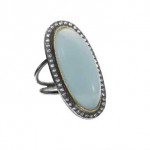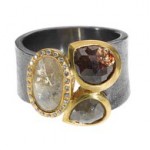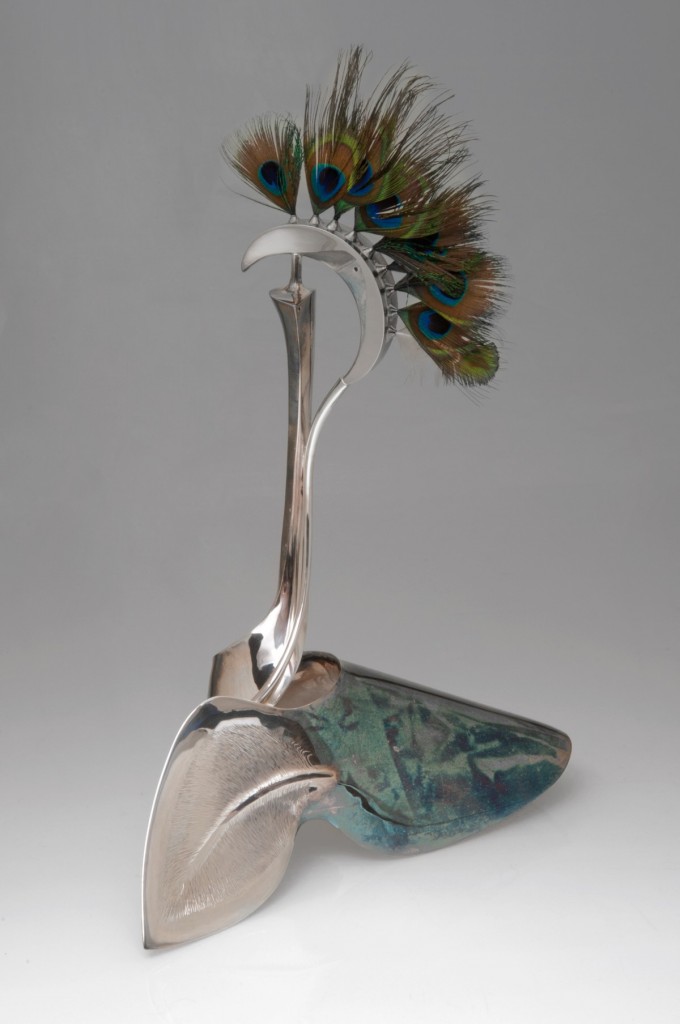“To those who need encouragement, remember this: Dr. Seuss’s first children’s book was rejected by twenty-three publishers. The twenty-fourth publisher sold six million copies.”
Ann Landers

“To those who need encouragement, remember this: Dr. Seuss’s first children’s book was rejected by twenty-three publishers. The twenty-fourth publisher sold six million copies.”
Ann Landers
While lines in jewelry design are often used to create movement or to guide a viewer’s eye around a piece, lines can do more. Artists can use lines to enhance or emphasis a surface. Continue reading

18kt YG and sterling ring, set with oval aquamarine (20.72ct) and white brilliant cut diamonds (0.705ct TW). Photo courtesy Todd Reed, Inc.
It’s been a truism that, for gemstones to sell, they had to be highly transparent, free from inclusions, and of good to excellent color, not to mention of the best modern cuts.

18kt YG and sterling ring set with three fancy cut diamonds, and round white brilliant diamonds. hoto courtesy Todd Reed, Inc.
That is changing, however. Imaginative jewelry designers now showcase the individuality and beauty of pale pastel and translucent varieties of gems such as aquamarine. Old-fashioned rose cuts Continue reading
One of the most common uses of line in design is to gently (or not so gently) tug the viewer’s eye in a guided tour of the work. They can do this because lines usually have direction. They lean forward or back. They curl around, widen and thin. Artists can use this directional tendency to tell the viewer: “See this? Now, see this? Now look over here.” Continue reading
Hiring a professional to do market research for you is expensive; it can run thousands of dollars. And while there may be a day you want to hire someone to do it for you, in the beginning, you may be able to do much of your market research yourself. Continue reading

Ridge peaks and places where two dissimilar materials meet are seen as lines. Floating Free, by Betty Helen Longhi. Courtesy of the artist.
Line is the most individual of marks. It is the first mark we make as children. Lines are the result of movement—stick in the sand, pen on paper. Because we each move with a different type and level of intention, a different force–whether we’re talking with our hands or doing daily chores–each of us draws or writes with a different line quality. In fact, the lines we make are so intimately tied to our unique ways of moving, that each of us has a unique signature, used for centuries for identification. Although how long that will last in a digital age is anyone’s guess. Continue reading
When deciding to make a production line of your artisan jewelry, an important consideration is whether your line will be unlimited or limited.
You may want to start out with an unlimited line, making as many copies of a piece as you can, especially if the design strikes a chord with buyers and sales are very good. However, depending on where you’re selling the pieces—say a department store chain or catalog—you can end up investing a lot of time in the making, and a lot of money in materials and supplies. Continue reading
“There is no failure except in no longer trying.”
Elbert Hubbard
There are two aspects to aesthetic design. First there are the elements of design (line, shape, form, space, texture, color, and—I believe when it comes to jewelry–light). These are the building blocks of design, like construction materials, cooking ingredients, or vocabulary. Then there are the principles of design (unity, variety, repetition, balance, contrast, and scale) which are guidelines to putting the elements together, like a blueprint, recipe, or rules of grammar. Continue reading

Peacock, by Heikki Seppä. Photo courtesy Nick Felkey.
When master metalsmith Heikki Seppä began his career as a metalsmith, silvermithing was strongly influenced—even dominated, according to Seppä–by the silver hollowware industry. Hollowware makers had become focused on speed and mass production. As a result, the forms they used to make tea and coffee pots, candlesticks, and other silver pieces, were greatly influenced by the prolific industrial use of rotation forms—forms that can be created on a lathe.
Other forms had been used in the past when silversmithing was still largely done by hand. But Seppä discovered that the language of these creative forms, forms that emphasized the fluidity of the metal rather than the speed of mass production, was rapidly disappearing. Continue reading